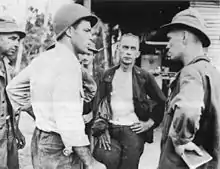Albert W. Waldron
Major General Albert Whitney Waldron (January 13, 1892 – June 21, 1961) was an American soldier and General during World War II. He replaced Major General Edwin F. Harding, as the commander of the 32nd Infantry Division during the Battle of Buna–Gona and was wounded in the shoulder on 5 December 1942 after being shot by a sniper. He received the Distinguished Service Cross and the Distinguished Service Medal for his actions during World War II.[1][2]
Albert Whitney Waldron | |
|---|---|
 General Albert W. Waldron (center, facing forward) commanding general, 32nd Division Artillery, discusses plans for the impending battle on 15 November 1942. | |
| Born | January 13, 1892 Rochester, New York |
| Died | June 21, 1961 (aged 69) San Francisco, California |
| Allegiance | |
| Service/ | |
| Years of service | 1915-1946 |
| Rank | |
| Service number | 0-3795 |
| Commands held | |
| Battles/wars | Pancho Villa Expedition World War I World War II |
| Awards | Distinguished Service Cross Distinguished Service Medal |
Early military career
Albert Whitney Waldron was born on January 13, 1892, in Rochester, New York. He attended the United States Military Academy at West Point, New York, in 1911 and graduated four years later as a part of "the class the stars fell on" (59 members of this class became general officers during World War II). For example: Dwight D. Eisenhower, Omar N. Bradley, James Van Fleet, Henry Aurand, Stafford LeRoy Irwin, John W. Leonard and others. He was commissioned a second lieutenant in field artillery on June 12, 1915.[3]
His first military assignment was with 4th Field Artillery Regiment stationed at Texas City, Texas. His unit was subsequently transferred to the Brownsville, Texas, where he served until March 1916, when he participated in Pancho Villa Expedition. After seven months of service in Mexico, Waldron returned to the United States in October 1916 and was stationed at Eagle Pass, Texas.
Decorations
Here is Major General Waldron´s ribbon bar:
| 1st Row | Distinguished Service Cross | Army Distinguished Service Medal | Purple Heart | |||||||||||||
|---|---|---|---|---|---|---|---|---|---|---|---|---|---|---|---|---|
| 2nd Row | Mexican Service Medal | World War I Victory Medal with four Battle Clasps | Army of Occupation of Germany Medal | American Defense Service Medal | ||||||||||||
| 3rd Row | Asiatic-Pacific Campaign Medal with two service stars | American Campaign Medal | World War II Victory Medal | French Croix de Guerre 1914–1918 with Palm | ||||||||||||
References
- "Valor Awards for Albert W. Waldron". Retrieved 12 December 2011.
- Cullum, George Washington (1950). "Biographical Register of the Officers and Graduates of the U.S. Military Academy at West Point, N.Y.: From Its Establishment, in 1802, to 1890; with the Early History of the United States Military Academy".
- "Waldron, Albert W. - Military Hall of Valor". militarytimes.com. Retrieved August 18, 2013.